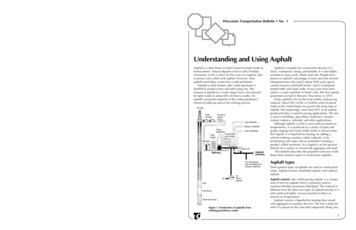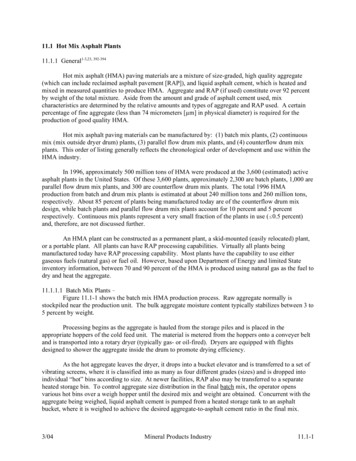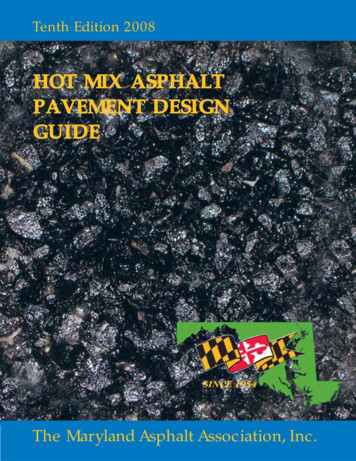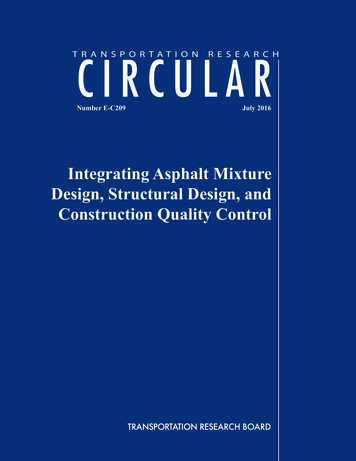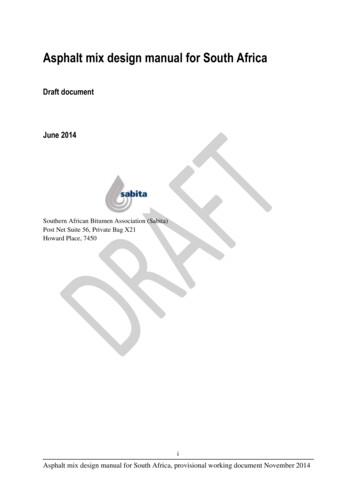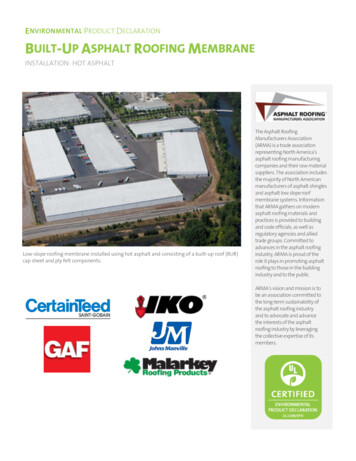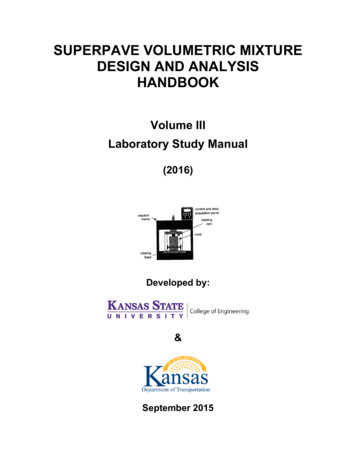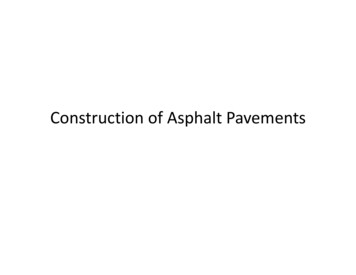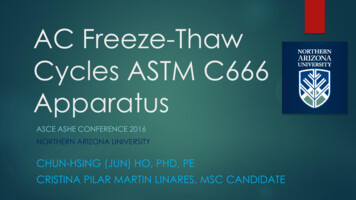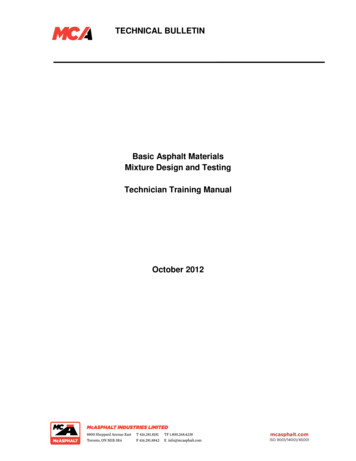
Transcription
TECHNICAL BULLETINBasic Asphalt MaterialsMixture Design and TestingTechnician Training ManualOctober 2012mcasphalt.comISO 9001/14001/45001
Table of ContentsPreface . 1Mix Design Fundamentals . 2Materials Physical Properties . 3Aggregate . 3Maximum Size . 3Gradation . 3Measurement . 3Typical HMA Gradations Blend . 4Aggregate Gradation Terms . 4Other Properties . 5Asphalt Cement . 6Asphalt Physical Properties . 6Grading Systems . 7Superpave Performance Grading (PG) System . 7Penetration Grading . 7Viscosity Grading . 8Asphalt Binder Modifiers . 8Marshall Method . 10Types of Mixes Used in Ontario . 11Basic Procedure . 12Superpave Mix Design . 13Traffic Load Estimation. 13PGAC Binder Selection . 14Aggregate Size Definitions . 15Traffic Categories . 15Compaction Effort. 18How to Choose . 19Mix Design Example. 19Asphalt Recycling Techniques. .32mcasphalt.comISO 9001/14001/45001
PrefaceThis training manual was developed as part of an effort to provide a step-by-step procedure forunderstanding basic asphalt mixture composition, creating mix designs and recycling processes.McAsphalt Industries LimitedOctober 20121
Mix Design FundamentalsHMA consists of two basic ingredients: aggregate and asphalt binder. HMA mix design is theprocess of determining what aggregate to use, what asphalt binder to use and what the optimumcombination of these two ingredients ought to be. There are several different methods used to goabout this process, of which the Marshall and Superpave methods are the most common.By manipulating the variables of aggregate, asphalt binder and the ratio between the two, mixdesign seeks to achieve the following qualities in the final HMA product (Roberts et al., 1996): Deformation resistance: HMA should not distort (rut) or deform (shove) undertraffic loading. HMA deformation is related to aggregate surface and abrasioncharacteristics, aggregate gradation, asphalt binder content and asphalt binderviscosity at high temperatures. Fatigue resistance: HMA should not crack when subjected to repeated loads overtime. HMA fatigue cracking is related to asphalt binder content and stiffness. Low temperature cracking resistance: HMA should not crack when subjected tolow ambient temperatures. Low temperature cracking is primarily a function of theasphalt binder low temperature stiffness. Durability: HMA should not age excessively during production and service life. HMAdurability is related to air voids as well as the asphalt binder film thickness aroundeach aggregate particle. Moisture damage resistance: HMA should not degrade substantially frommoisture penetration into the mix. Moisture damage resistance is related to air voidsas well as aggregate mineral and chemical properties. Skid resistance: HMA placed as a surface course should provide sufficient frictionwhen in contact with a vehicle's tire. Low skid resistance is generally related toaggregate characteristics or high asphalt binder content. Workability: HMA must be capable of being placed and compacted with reasonableeffort. Workability is generally related to aggregate texture/shape/size/gradation,asphalt binder content and asphalt binder viscosity at mixing and placementtemperatures.McAsphalt Industries LimitedOctober 20122
Materials Physical PropertiesAggregateAggregates can be classified by their mineral, chemical and physical properties. The pavementindustry typically relies on physical properties for performance characterization. An aggregate'sphysical properties are a direct result of its mineral and chemical properties.Maximum SizeMaximum aggregate size can affect HMA and base/Subbase courses in several ways. In HMA,instability may result from excessively small maximum sizes; and poor workability and/orsegregation may result from excessively large maximum sizes (Roberts et al., 1996). ASTM C125 defines the maximum aggregate size in one of two ways:Maximum size: The smallest sieve through which 100 percent of the aggregate sample particlespass. Superpave defines the maximum aggregate size as "one sieve larger than the nominalmaximum size" (Roberts et al., 1996).Nominal maximum size: The largest sieve that retains some of the aggregate particles butgenerally not more than 10 percent by weight. Superpave defines nominal maximum aggregatesize as "one sieve size larger than the first sieve to retain more than 10 percent of the material"(Roberts et al., 1996).It is important to specify whether "maximum size" or "nominal maximum size" is being referenced.GradationAn aggregate's particle size distribution, or gradation, is one of its most influential characteristics.In HMA, gradation helps determine almost every important property including stiffness, stability,durability, permeability, workability, fatigue resistance, frictional resistance and resistance tomoisture damage (Roberts et al., 1996). Because of this, gradation is a primary concern in HMAmix design and thus most agencies specify allowable aggregate gradations.MeasurementGradation is usually measured by a sieve analysis. In a sieve analysis, a sample of dry aggregateof known weight is separated through a series of sieves with progressively smaller openings.Once separated, the weight of particles retained on each sieve is measured and compared to theMcAsphalt Industries LimitedOctober 20123
total sample weight. Particle size distribution is then expressed as a percent passing by weight oneach sieve size.Typical HMA Gradations BlendDense or well-graded: Refers to a gradation that is near maximum density. The most commonHMA mix designs tend to use dense graded aggregate.Gap graded: Refers to a gradation that contains only a small percentage of aggregate particlesin the mid-size range. The curve is near-horizontal in the mid-size range. These mixes can beprone to segregation during placement.Open graded: Refers to a gradation that contains only a small percentage of aggregate particlesin the small range. This results in more air voids because there are not enough small particles tofill in the voids between the larger particles. The curve is near-horizontal and near-zero in thesmall-size range.Uniformly graded: Refers to a gradation that contains most of the particles in a very narrow sizerange In essence, all the particles are the same size, The curve is steep and only occupies thenarrow size range specified.Aggregate Gradation TermsFine aggregate: (sometimes just referred to as "fines"). Defined by AASHTO M 147 as natural orcrushed sand passing the 4.75mm and mineral particles passing the 75um sieve.Coarse aggregate: Defined by AASHTO M 147 as hard, durable particles or fragments of stone,gravel or slag retained on the 4.75mm sieve. Usually coarse aggregate has a toughness andabrasion resistance requirement.Fine gradation: A gradation that, when plotted on the 0.45 power gradation graph, falls mostlyabove the 0.45 power maximum density line. The term generally applies to dense gradedaggregate.Coarse gradation: A gradation that, when plotted on the 0.45 power gradation graph, falls mostlybelow the 0.45 power maximum density line. The term generally applies to dense gradedaggregate.Mineral filler: Defined by the Asphalt Institute as a finely divided mineral product at least 65percent of which will pass through 75um sieve. Pulverized limestone is the most commonlyMcAsphalt Industries LimitedOctober 20124
manufactured mineral filler, although other stone dust, silica, hydrated lime, Portland cement andcertain natural deposits of finely divided mineral matter are also used (Asphalt Institute, 1962).Other PropertiesOther important aggregate physical properties are:Toughness and abrasion resistance: Aggregates should be hard and tough enough to resistcrushing, degradation and disintegration from activities such as manufacturing, stockpiling,placing and compaction.Durability and soundness: Aggregates must be resistant to breakdown and disintegration fromweathering (wetting/drying) or else they may break apart and cause premature pavementdistress.Particle shape and surface texture: Particle shape and surface texture are important for propercompaction, load resistance and workability. Generally, cubic angular-shaped particles with arough surface texture are best.Specific gravity: Aggregate specific gravity is useful in making weight-volume conversions andin calculating the void content in compacted HMA (Roberts et al., 1996).Cleanliness and deleterious materials: Aggregates must be relatively clean when used inHMA. Vegetation, soft particles, clay lumps, excess dust and vegetable matter may affectperformance by quickly degrading, which causes a loss of structural support and/or preventsbinder-aggregate bonding.McAsphalt Industries LimitedOctober 20125
Asphalt CementAsphalt cement refers to asphalt that has been prepared for use in HMA and other pavingapplications. In HMA a generic term, "asphalt binder", to represent the principal binding agent inHMA because "asphalt binder" includes asphalt cement as well as any material added to modifythe original asphalt cement properties.Asphalt Physical PropertiesAsphalt can be classified by its chemical composition and physical properties. The pavementindustry typically relies on physical properties for performance characterization although asphalt’sphysical properties are a direct result of its chemical composition. Typically, the most importantphysical properties are:Durability: Durability is a measure of how asphalt binder physical properties change with age(sometimes called age hardening). In general, as an asphalt binder ages, its viscosity increasesand it becomes more stiff and brittle.Rheology: Rheology is the study of deformation and flow of matter. Deformation and flow of theasphalt binder in HMA is important in HMA pavement performance. HMA pavements that deformand flow too much may be susceptible to rutting and bleeding, while those that are too stiff maybe susceptible to fatigue cracking.Safety: Asphalt cement like most other materials, volatilizes (gives off vapor) when heated. Atextremely high temperatures (well above those experienced in the manufacture and constructionof HMA) asphalt cement can release enough vapor to increase the volatile concentrationimmediately above the asphalt cement to a point where it will ignite (flash) when exposed to aspark or open flame. This is called the flash point. For safety reasons, the flash point of asphaltcement is tested and controlled.Purity: Asphalt cement, as used in HMA paving, should consist of almost pure bitumen.Impurities are not active cementing constituents and may be detrimental to asphalt performance.McAsphalt Industries LimitedOctober 20126
Grading SystemsAsphalt binders are typically categorized by one or more shorthand grading systems according totheir physical characteristics. These systems range from simple to complex and represent anevolution in the ability to characterize asphalt binder. In Ontario the Superpave performancegrading (PG) system is specified.Superpave Performance Grading (PG) SystemThe Superpave PG system was developed as part of the Superpave research effort to moreaccurately and fully characterize asphalt binders for use in HMA pavements. The PG system isbased on the idea that an HMA asphalt binder’s properties should be related to the conditionsunder which it is used. For asphalt binders, this involves expected climatic conditions as well asaging considerations. Therefore, the PG system uses a common battery of tests (as the olderpenetration and viscosity grading systems do) but specifies that a particular asphalt binder mustpass these tests at specific temperatures that are dependent upon the specific climatic conditionsin the area of intended use.Superpave performance grading is reported using two numbers – the first being the averageseven-day maximum pavement temperature (in C) and the second being the minimum pavementdesign temperature likely to be experienced (in C). Thus, a PG 58-28 is intended for use wherethe average seven-day maximum pavement temperature is 58 C and the expected minimumpavement temperature is -28 C. Notice that these numbers are pavement temperatures and notair temperatures. For example, the typical PG grade used in Central Ontario is a PG 58-28.Realistically, pavement temperatures in Central Ontario will never drop down to -28 C, but thetypical asphalt binder used will meet this standard so it is graded as such, grades are bumped upto account for effect of increase traffic loading or down to account for variables such as increasedrecycle content.Penetration GradingBased on the depth a standard needle will penetrate an asphalt binder sample when placedunder a 100 g load for 5 seconds. The test is simple and easy to perform but it does not measureany fundamental parameter and can only characterize asphalt binder at one temperature (25 C).Penetration grades are listed as a range of penetration units (one penetration unit 0.1 mm ofpenetration by the standard needle). Typical asphalt binders previously used in the U.S. are 6570 pen and 85-100 pen. This grading system is no longer used in Ontario.McAsphalt Industries LimitedOctober 20127
Viscosity GradingMeasures penetration (as in penetration grading) but also measures an asphalt binder's viscosityat 60 C and 135 C. Testing can be done on virgin (AC) or aged (AR) asphalt binder. Grades are2listed in poises (cm-g-s dyne-second/cm ) or poises divided by 10. Typical asphalt binders usedin the U.S. are AC-10, AC-20, AC-30, AR-4000 and AR-8000. Viscosity grading is a bettergrading system but it does not test low temperature asphalt binder Rheology. This gradingsystem is no longer used in Ontario as well.Asphalt Binder ModifiersSome asphalt cements require modification in order to meet specifications. Asphalt cementmodification has been practiced for over 50 years but has received added attention in the pastdecade or so. There are numerous binder additives available on the market today. The benefits ofmodified asphalt cement can only be realized by a judicious selection of the modifier(s); not allmodifiers are appropriate for all applications. In general, asphalt cement should be modified toachieve the following types of improvements (Roberts et al., 1996):Lower stiffness (or viscosity) at the high temperatures associated with construction. Thisfacilitates pumping of the liquid asphalt binder as well as mixing and compaction of HMA.Higher stiffness at high service temperatures. This will reduce rutting and shoving.Lower stiffness and faster relaxation properties at low service temperatures. This willreduce thermal cracking.Increased adhesion between the asphalt binder and the aggregate in the presence ofmoisture. This will reduce the likelihood of stripping. Asphalt binder used with the right percent(by weight of asphalt binder) of an anti-stripping modifier if required, will results in goodaggregate-asphalt binder adhesion.Other Forms of Asphalt Used in PavingBesides asphalt cement, three other forms of asphalt are used prominently in the paving industry: Emulsified asphalt. Emulsified asphalt is a suspension of small asphalt cementglobules in water, which is assisted by an emulsifying agent (such as soap).Emulsions have lower viscosities than neat (plain) asphalt and can thus be used inlow temperature applications. After an emulsion is applied the water evaporatesaway (breaks) and only the asphalt cement is left. Emulsions are often used as primecoats and tack coats.McAsphalt Industries LimitedOctober 20128
Cutback asphalt. Cutback asphalt is a combination of asphalt cement and petroleumsolvent. Like emulsions, cutbacks are used because their viscosity is lower than thatof neat asphalt and can thus be used in low temperature applications. After a cutbackis applied the solvent evaporates away and only the asphalt cement is left. Cutbacksare much less common today because the petroleum solvent is more expensive thanwater and can be an environmental concern. Cutbacks are typically used as primecoats and tack coats. Foamed asphalt. Foamed asphalt is formed by combining hot asphalt binder withsmall amounts of cold water. When the cold water comes in contact with the hotasphalt binder it turns to steam, which becomes trapped in tiny asphalt binderbubbles (World Highways, 2001). The result is a thin-film, high volume asphalt foam.This high volume foam state only lasts for a few minutes, after which the asphaltbinder resumes its original properties. Foamed asphalt can be used as a binder insoil or base course stabilization, and is often used as the stabilizing agent in cold inplace recycling (CIPR).McAsphalt Industries LimitedOctober 20129
Marshall Mix Design MethodThe basic concepts of the Marshall Mix design method were originally developed by BruceMarshall of the Mississippi Highway Department around 1939 and then refined by the U.S. Army.Typically, the Marshall Mix design method consists of three basic steps:1. Aggregate selection: Different agencies/owners specify different methods of aggregateacceptance. Private labs may or may not run periodic aggregate physical tests on a particularaggregate source. For each mix design, gradation and size requirements are checked. Often,aggregate from more than one source is required to meet gradation requirements.2. Asphalt binder selection: Review the contract document to determine the specified bindergrade.3. Optimum asphalt binder content determination: In the Marshall method, this step can bebroken up into 5 sub steps:I. Prepare a series of initial samples, each at different asphalt binder content. Forinstance, two to three samples each might be made at 4.5, 5.0, 5.5, 6.0 and 6.5 percentasphalt by dry weight for a total of 10 to 15 samples. There should be at least twosamples above and two below the estimated optimum asphalt content.II. Compact these trial mixes using the Marshall drop hammer. This hammer is specific tothe Marshall Mix design method.III. Test the samples in the Marshall testing machine for stability and flow. This testingmachine is specific to the Marshall Mix design method. Passing values of stability andflow depend upon the mix class being evaluated.IV. Determine the density and other volumetric properties of the samples. Select theoptimum asphalt binder content. The asphalt binder content corresponding to 4 percentair voids is selected as long as this binder content passes stability and flowrequirements.V. A quicker way is to run trials based on aggregate blending, test properties, varyingasphalt cement content – the trial blend that gives 4 percent air voids and meetspecifications is selected.VI.McAsphalt Industries LimitedOctober 201210
Types of Mixes Used in OntarioTable 1: Summary of types of Marshall Mixes used in OntarioHot Mix TypeAbbreviationDense Friction CourseDFCHot Laid 1HL 1Summary of Hot Mix Use and PropertiesA dense-graded surface course mix with highfrictional resistance for high volume roadsA dense-graded surface course mix with a premiumquality coarse aggregateA sand mix used primarily as a leveling course onHot Laid 2HL 2existing pavements or surface course on low speedtraffic areas requiring thin overlayHot Laid 3Hot Laid 3 High StabilityHL 3HL 3HSHot Laid 3 FineHL 3FHot Laid 4HL 4Hot Laid 4 FineHL 4FHot Laid 8HL 8Medium Duty BinderCourseHeavy Duty BinderCourseMcAsphalt Industries LimitedMDBCHDBCA dense-graded surface course mix for intermediatevolume roadsA dense-graded padding and leveling mix of highstabilityA fine-graded used as a surface course where handwork is necessary for placementA dense-graded mix used as a surface or bindercourse on low volume roadsA fine-graded mix used a s surface course wherehand work is necessary for placementA coarse-graded binder course mixA binder course mix intended for use in locationswhere rutting and deformation is likelyA high stability binder mix designed to providesuperior resistance to ruttingOctober 201211
Basic ProcedureSTART#1 Heat aggregates & asphalt tospecified temperature.#2 Remove aggregates & asphaltfrom ovens.#3 Place proportioned aggregates& asphalt into mixer. Mix untilaggregate is fully coated.#4 Cure mix in oven covered withaluminum foil for 2 hours at135oC.#5 Prepare the gyratory compactor(for Superpave method). Placemolds in oven for 60 minutes.#6 Compact using gyratorycompactor (Superpave).Compact using MarshallHammer (Marshall)#7 Extract specimen after shortperiod of cooling. I.D.specimen. Let cool further thendetermine volumetric propertiesAdjust mix designbased on testresultsNoVolumetricproperties withinspecification?YesContinue to PerformanceTestingMcAsphalt Industries LimitedOctober 201212
Superpave Mix Design MethodThis section of the manual will cover the essentials to the Superpave Mix Design process. Anexample is included which places emphasis on developing the trial batch weights andpercentages, which should be summarized on a mix design worksheet that the QC Lab personnelwill use for making the hot mix asphalt (HMA) specimen.Traffic Load Estimation100 kN22,000 lb.80 kN18,000 lb.1ESAL44 kN10,000 lb.2.2ESAL.09ESALFigure 1: ESAL comparison67 kN15,000 lb0.48 ESAL151 kN34,000 lb1.10 27 kN6,000 lb0.01 ESAL151 kN34,000 lb1.10 0.49 ESALs54 kN 12,000 lb 0.192.39 ESALsFigure 2: Example ESALs calculationMcAsphalt Industries LimitedOctober 201213
PGAC Binder SelectionThe PGAC grading system is a function of environment and traffic level. Figure 3 below showsPGAC grading recommendation for various zones (environments).PG 52-34PG 58-34PG 58-28Figure 3: PGAC grades for different zonesAnother factor that affects binder selection is effect of loading rate.Example:For toll road with speed of 90 km/hRecommended: PGAC 64-22For toll booth with slow moving trafficRecommended: PGAC 70-22For weigh stations that involve a lot of stoppingRecommended: PGAC 76-22McAsphalt Industries LimitedOctober 201214
Aggregate Size DefinitionsTable 2: Primary Control Sieve designationsPrimary Control Sieve (PCS) Control Point for MixtureNominal Maximum Aggregate Size (% Passing)Nominal MaximumAggregate Size (mm)Primary Control Sieve(mm)PCS Control Point(% 473747control pointnommaxsizemaxsize100max density linerestrictedzone00.0750.32.364.759.512.5Sieve Size (mm) raised to 0.45 power19.0Figure 4: Aggregate blend gradation chart with Superpave gradation limitsAggregate Consensus PropertiesFlat, Elongated or Flat and Elongated (F&E)Definition:-Flat, or Elongated particles of aggregate are those particles of aggregate having a ratio of widthor length to width greater than a specified value.-Flat and Elongated particles of aggregate are those particles having a ratio of length to thicknessgreater than a specified value.* Length – maximum dimension of the particle* Width – maximum dimension in the plane perpendicular to the length* Thickness – maximum dimension perpendicular to the length and widthMcAsphalt Industries LimitedOctober 201215
Summary of Test Method:Individual particles of aggregate of specified sieve sizes are measured to determine the ratio ofwidth to thickness; length to width, or length to thickness.Significance and UseFlat or Elongated particles of aggregates, for some construction uses, may interfere withconsolidation and result in harsh, difficult to place materials.This test provides a means for checking compliance with specifications that limits such particlesor to determine the relative shape characteristics of coarse aggregates.Procedure:Use materials retained on sieve size 4.75mm (No.4), reduce each size fraction present to 100particles for each size fraction required.Test ProcedureSet the larger opening equal to the length of the particle. The particle is flat and elongated if whenoriented to measure its thickness, can pass completely through the smaller opening of the caliper.On the caliper, set the minimum dimension of the caliper device such that the particle, whenoriented to measure its thickness, passes smugly between the post and swing arm. The particleis flat and elongated if the particle, when oriented to measure its length, fails to pass the desiredlarge opening of the caliper device.After the particles have been classified into group, determine the proportion of the sample in eachgroup by count or mass as required.Calculation:Calculate the percentage of flat and elongated particles to the nearest 1% for each sieve sizegreater than 9.5mm or 4.75mm.Sand Equivalent Test (SE)Scope:This test is intended to serve as a rapid field test to show the relative proportion of fine dust orclaylike material in the soil or graded aggregate.Sample Preparation:(a) The sand equivalent test shall be performed on aggregate materials passing the 4.75mmsieve size, and all fines shall be cleaned from particles retained on the 4.75mm sieve andincluded with the materials passing 4.75mm sieve.(a) Split the sample to fill the 85mL (3oz) tin measure so it is slightly rounded above the brim,while filling tap the bottom edge to cause consolidation of the material and allowmaximum amount to be placed in the tin. Strike off the top of the tin with a spatula.(b) Add solution about 101.6 /-2.5 (4.0 /-0.1in) of working calcium chloride solution intocylinder. Allow to stand, sample and solution for about 10min /- 1min. At the end of thetime, stopper the cylinder, the loose the materials from the bottom by partially invertingthe cylinder and shaking it simultaneously. After loosing the materials shake the cylinderand content manually, hand holding in a horizontal position, shake it vigorously in ahorizontal linear motion from end to end. Shake the cylinder 90 cycles in approximately30secounds using a throw 229 /- 25 (9 /-1in). A cycle is defined as a complete backand forth motion.(c) After shaking, set the cylinder upright on the work table and remove stopper. Irrigate byinserting irrigator tube and working the sample down and rinsing materials from the bodyof the cylinder, release solution up to 381mm, raise irrigator and top up solution to381mm mark on cylinder.McAsphalt Industries LimitedOctober 201216
(d) Allow cylinder and content to stand for 20mm /-15secounds. Start a timer immediatelyafter withdrawing the irrigator tube.(e) At the end of 20min. sedimentation period, read and record the level of the top of claysuspension. This is referred to as “clay reading”. After clay reading, take the “sandreading” by the weighted foot assembly having the sand indicator on the rod of theassembly, place the gently on the sand and make contact with the cylinder body.Subtract 254mm(10in.) from the level indicator by extreme top edge of the indicator andrecord this val
Basic Asphalt Materials Mixture Design and Testing Technician Training Manual October 2012. . understanding basic asphalt mixture composition, creating mix designs and recycling processes. McAsphalt Industries Limited October 2012 2 Mix Design Fundamentals HMA consists of two basic ingredients: aggregate and asphalt binder. HMA mix design is the

